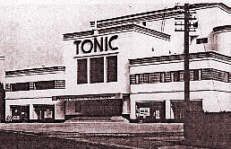 His star turn was the 2,000 seat Tonic
in the seaside resort of Bangor, a few miles from Belfast, which
was opened in 1936. It closed in 1983 and it burned down in 1992. Sheltered housing has been built on the site.
His star turn was the 2,000 seat Tonic
in the seaside resort of Bangor, a few miles from Belfast, which
was opened in 1936. It closed in 1983 and it burned down in 1992. Sheltered housing has been built on the site.
Cinemas outside Dublin / Belfast
Belfast and the suburbs of Belfast had a good crop of deco style cinemas. Many were by a fine local architect John Mc Bride Neill. His work later became more influenced by the international style.
 His star turn was the 2,000 seat Tonic
in the seaside resort of Bangor, a few miles from Belfast, which
was opened in 1936. It closed in 1983 and it burned down in 1992. Sheltered housing has been built on the site.
His star turn was the 2,000 seat Tonic
in the seaside resort of Bangor, a few miles from Belfast, which
was opened in 1936. It closed in 1983 and it burned down in 1992. Sheltered housing has been built on the site.
The entrance was framed by two story wings, with rental shops
on the ground
level and flats on the first floor. The cinema had a cafe. The facade alternated rustic brick with
white snowcrete. The developer J H O'Neill had been well known as a bus
operator, who ran a fleet of "Tonic" buses between Belfast and Bangor
until that service was nationalised in 1935. At an early stage the cinema came to be operated by the Curran family, who came to control a large number of Ulster cinemas. It later passed to the Rank Organisation.
The contractors or the Tonic were Sloan Brothers of Belfast and the Tonic was
opened on the 6 July 1936, just in good time for the holiday peak season in
Northern Ireland, which is traditionally around the time of the Twelfth of
July celebrations. A Compton organ was also installed.
Supposedly costing some £76,000 to build , - almost four times the compensation he was paid for the vanished bus company business incidentally, - the new cinema seems relatively expensive. At this time the Rank/Odeon chain, who were later to control the Tonic, operating in the more expensive English construction market, were building cinemas of this size for c £35,000 / £45,000, with the site and fitting out costs extra. Whatever the cost it was an unusually good-looking cinema. Perhaps this high cost gave a particular relevance to the choice of the first film to be screened at the opening.
The first feature shown was "The Man who broke the Bank at Monte Carlo".
John Mc Bride Neill had, in 1933, also refaced
the Savoy Hotel in Bangor in a moderne style for the same developer. (The
Savoy Hotel had been built as recently as 1932 and it seems to have been considered that the original facade was too gloomy.) That is still there but also now used as sheltered housing.
Decline of cinema going and "The Troubles"
have put paid to most of his other cinemas in recent years. The Majestic, closed in
1973, still stands on Lisburn Road, now used as a furniture warehouse and the
more international style Curzon dating from 1936 also remains, - but with interior divisions and exterior modifications.
Stop Press January 2000 - the Curzon closed in April 1999 for redevelopment, and the present status is unknown. The Strand, by Mc Bride Neill, dating from 1935 is now a four screen cinema. It has just been refurbished with a very sensitive restyling, which respects Mc Bride Neill's original and gives it a fine neon look at night.
Other Belfast cinemas with deco exteriors were the 2,200
seater> Ritz, later called the ABC, which opened in 1936 and was demolished in
1993>and the Picturedrome Mt Pottinger Road. The Picturedrome cinema, originally opened in 1911/12 was completely rebuilt in 1934 in a pronounced art deco exterior style, with zig zag glass exterior windows.
Early photographs
of the 1,400 seat Stadium cinema, on the Shankill Road which opened in 1937 , show a distinctly art deco
foyer, with a mural apparently illustrating scenes from the industrial
life of Belfast. The Stadium ,which was an auditorium style cinema also had a stage and dressing rooms. The Broadway cinema, is also gone, and had deco style fins on the exterior of this 1,500 seater super cinema. A fire bomb, in 1972, closed the Broadway for ever.
A fine illustrated article on John Mc Bride Neill by Paul Larmour is in the magazine
"Perspective", volume 5 number 4, 1997.